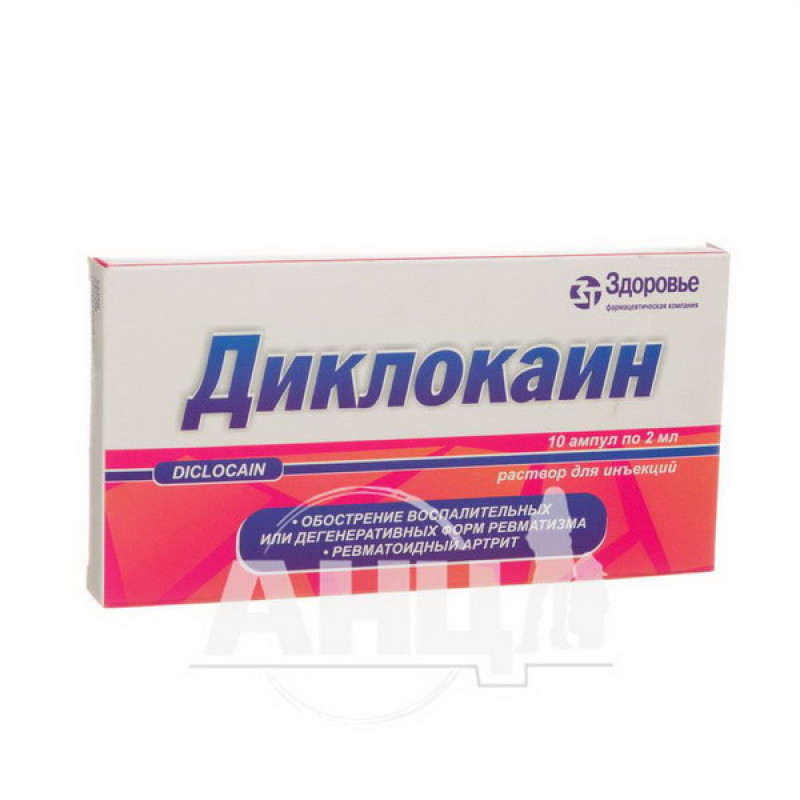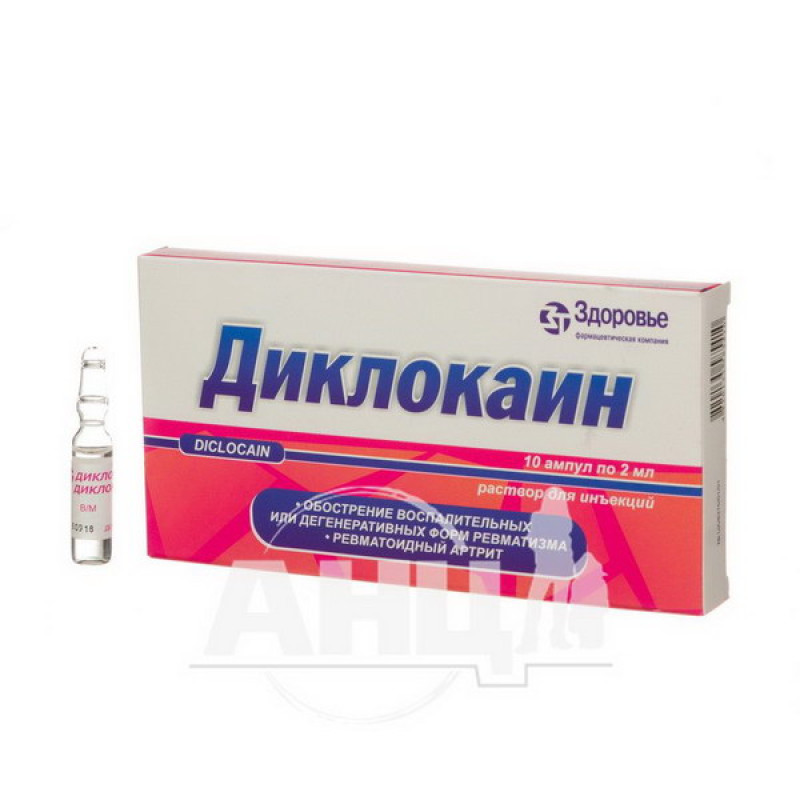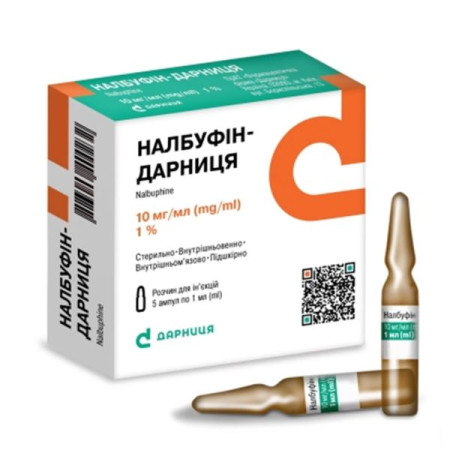Diclocaine solution for injection ampoule 2 ml No. 10

Pharmacological properties
Diclocaine has a pronounced anti-inflammatory, analgesic, antipyretic and antiplatelet effect, due to the inhibition of the biosynthesis of prostaglandins and other mediators of inflammation and pain, a decrease in capillary permeability and a stabilizing effect on lysosomal membranes. slows down the formation of proteoglycan in cartilage tissue. Lidocaine, which is part of the drug, reduces pain at the injection site. In rheumatic diseases, the anti-inflammatory and analgesic properties of the drug contribute to the reduction of the severity of symptoms such as pain at rest and during movement, morning stiffness, swelling of the joints. It has a strong analgesic effect in moderate and severe pain syndrome of a non-rheumatic nature. In inflammatory processes that occur after operations and injuries, it quickly reduces both spontaneous pain and inflammatory swelling of the wound.
When administered intramuscularly, diclofenac is rapidly and completely absorbed. The maximum serum concentration (1.5 μg/ml) after intramuscular administration is reached after 10-30 minutes. The serum concentration is linearly dependent on the dose of the drug. Biotransformation occurs as a result of multiple or single hydroxylation or conjugation with glucuronic acid. 60% of diclofenac is excreted in the form of metabolites through the kidneys; less than 1% - in unchanged form, the rest - in the form of metabolites with bile.
Indication
As an analgesic, anti-inflammatory and antipyretic in the acute period of rheumatoid arthritis, ankylosing spondylitis, acute gouty, infectious, psoriatic and traumatic arthritis, osteoarthritis, bursitis, tendovaginitis, radiculitis, thrombophlebitis, neuralgia, myalgia, adnexitis, renal and hepatic colic and other diseases accompanied by inflammation, pain syndrome and fever.
Application
Administered intramuscularly (deep into the gluteal muscle) 2 ml 1-2 times a day. The course of treatment is 3-5 days, after which you should switch to the use of diclofenac in the form of tablets or suppositories. Diclofenac injections can be combined with taking diclofenac tablets, while the total daily dose should not exceed 150 mg.
Contraindication
Gastric and duodenal ulcer, gastrointestinal bleeding, hematopoietic disorders, hypersensitivity to diclofenac or lidocaine, pregnancy or breastfeeding.
Side effects
Some patients may experience nausea, belching, epigastric discomfort, dizziness, headache, and allergic reactions. These phenomena usually disappear on their own and do not require discontinuation of the drug. Other side effects typical of nonsteroidal anti-inflammatory drugs (liver and kidney dysfunction, hematopoiesis disorders) occur extremely rarely during treatment with Diclocaine.
Special instructions
Patients with a history of allergic reactions to nonsteroidal anti-inflammatory drugs should only be given Diclocain as an emergency treatment. It should be used with caution in patients with a history of liver, kidney, or gastrointestinal diseases, in patients with hypertension, heart failure, and in the elderly. During treatment, systematic monitoring of the functional state of the liver, kidneys, and peripheral blood composition is recommended.
Due to the important role of prostaglandins in maintaining renal blood flow, special caution should be exercised when prescribing the drug to patients with heart or kidney failure, as well as to elderly people taking diuretics, and with reduced BCC (for example, after major surgery). If Diclocaine is prescribed in such cases, it is recommended to monitor renal function. With prolonged use of the drug, it is necessary to monitor liver function and the composition of peripheral blood.
During treatment, a decrease in the speed of mental and motor reactions is possible.
There is no experience with the use of the drug in pediatrics.
Interactions
Dicloocaine can weaken the effect of thiazide and loop diuretics, increase the concentration of digoxin, lithium and cyclosporine in the blood serum. Against the background of the use of potassium-sparing diuretics, the risk of developing hyperkalemia increases, anticoagulants - the risk of bleeding. When combined with anticoagulants, control of the anticoagulant effect is necessary. Reduces the effect of diuretics, hypotensive and hypnotics. Increases the likelihood of side effects of NSAIDs and GCS (gastrointestinal bleeding), methotrexate toxicity and cyclosporine nephrotoxicity. Acetylsalicylic acid reduces the concentration of diclofenac in the blood plasma. When used simultaneously with antidiabetic drugs, both hypo- and hyperglycemia are possible.
Overdose
Dizziness, headache, hyperventilation of the lungs, confusion, nausea, vomiting, abdominal pain. Treatment is symptomatic.
Storage conditions
In a place protected from light at a temperature of 15-25 °C.
There are no reviews for this product.
There are no reviews for this product, be the first to leave your review.
No questions about this product, be the first and ask your question.







